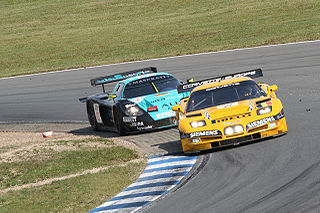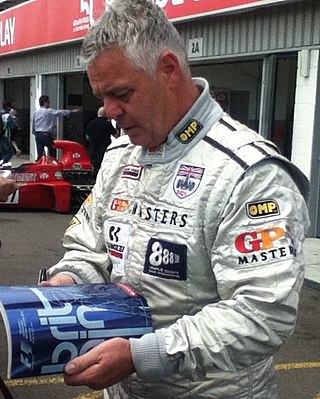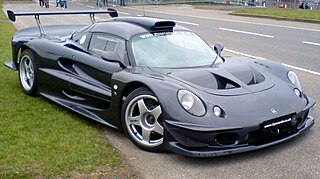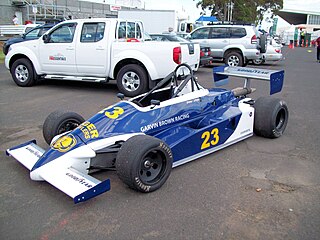
Sports car racing is a form of motorsport road racing which utilises sports cars that have two seats and enclosed wheels. They may be purpose-built prototypes or grand tourers based on road-going models. Broadly speaking, sports car racing is one of the main types of circuit auto racing, alongside open-wheel racing, touring car racing and stock car racing. Sports car races are often, though not always, endurance races that are run over particularly long distances or large amounts of time, resulting in a larger emphasis on the reliability and efficiency of the car and its drivers as opposed to outright car performance or driver skills. The FIA World Endurance Championship is an example of a sports car racing series.

Jan Lammers is a racing driver from the Netherlands whose most notable claim to fame is victory in the 1988 Le Mans 24 Hours for Silk Cut Jaguar/TWR, next to a four-season spell in Formula One in 1979-1982, driving for Shadow, ATS, Ensign and Theodore. This was followed by a comeback with March for two races in 1992, after a world-record time gap of ten years.

A Le Mans Prototype (LMP) is the type of sports prototype race car used in the 24 Hours of Le Mans, FIA World Endurance Championship, IMSA SportsCar Championship, European Le Mans Series and Asian Le Mans Series. Le Mans Prototypes were created by the Automobile Club de l'Ouest (ACO). The technical requirements for an LMP include bodywork covering all mechanical elements of the car. Currently, there are three classes within Le Mans Prototypes, designated LMP1, LMP2, and LMP3.

The Lister Storm was a homologated GT racing car manufactured by British low volume automobile manufacturer Lister Cars with production beginning in 1993. The Storm used the largest V12 engine fitted to a production road car since World War II, a 7.0 L Jaguar unit based on the one used in the Jaguar XJR-9 that competed at the 24 Hours of Le Mans. Due to the high price of the vehicle at £220,000, only four examples were produced before production of the road-going Storm ceased. Only three Storms survive today, although the company continues to maintain racing models. The Storm was the fastest four-seat grand tourer during the 1990s and early 2000s.

The Aston Martin DBR9 is a racing car built by Aston Martin Racing, debuting in 2005 and racing actively in international sportscar racing until the end of GT1 category in 2011. The name DBR9 is derived from the original 24 Hours of Le Mans-winning DBR1 car, named for then-owner David Brown, which not only won the 24 Hour race in 1959 but also the World Sportscar title. The car is most famous for taking two LMGT1 class wins at Le Mans 24 Hours by the Aston Martin Racing factory team.

Group C was a category of sports car racing introduced by the FIA in 1982 and continuing until 1993, with Group A for touring cars and Group B for GTs.

The World Sportscar Championship was the world series run for sports car racing by the FIA from 1953 to 1992.

The Chevrolet Corvette C5-R is a grand touring racing car built by Pratt & Miller and Chevrolet for competition in endurance racing. The car is based on the C5 generation of the Chevrolet Corvette sports car, yet is designed purely for motorsports use. It became one of the most successful cars in GT categories, with wins at the 24 Hours of Daytona, 12 Hours of Sebring, and 24 Hours of Le Mans, as well as championships in the American Le Mans Series. The Corvette C5-Rs debuted in 1999 and continues to be raced to this day in vintage racing events, although the C5-R was effectively replaced by the Corvette C6.R in 2005.

Warren Hughes is a racing driver from Sunderland, England.

The 1992 Sportscar World Championship season was the 40th and final season of FIA World Sportscar Championship motor racing. It featured the 1992 FIA Sportscar World Championship, which was contested over a six race series which ran from 26 April to 18 October 1992. The championship was open to Group C Sportscars.

The Lotus Elise GT1 is a race car developed for grand tourer-style sports car racing starting in 1997.

Spice Engineering was a British racing team founded by driver Gordon Spice with Raymond Bellm in the early 1980s, later becoming a successful sports car constructor in 1986. They competed in the World Sportscar Championship in Europe as well as the IMSA GT Championship in North America, at times partnering with major manufacturers such as General Motors and Honda as well as race engine manufacturer Comptech.

The Chevrolet Corvette C6.R is a grand tourer racing car built by Pratt & Miller and Chevrolet for competition in endurance racing. It is a replacement for the Corvette C5-R racing car, applying the body style of the new C6 generation Chevrolet Corvette as well as improvements to increase the speed and reliability on the track. Since its debut in 2005, it has continued on from the previous dominance of the C5-R in its racing class with multiple American Le Mans Series championships and race wins in the Le Mans Series, FIA GT Championship, and 24 Hours of Le Mans. There are two main versions of the Corvette C6.R: the GT1 version which has 590 HP, carbon-ceramic brakes, and aggressive aerodynamics, and the GT2 version which has 470 HP, cast-iron brakes, and relatively stock aerodynamics with respect to the road car. Unrestricted though, the LS7.R engine will produce around 800 hp. By 2012 the C6.R GT1 was retired from the competition while the GT2 version continues to race around the world.

The Chrysler Viper GTS-R was a successful racing variant of the Dodge Viper developed in conjunction with Chrysler of North America, Oreca of France, and Reynard Motorsport of the United Kingdom. Officially unveiled at the 1995 Pebble Beach Concours, it has won numerous championships and famous events in its history. Some chassis are still in use today.

Tiga Race Cars Ltd. was a British auto racing constructor and team. The company was founded in 1974 by two former Formula 1 drivers, Australian Tim Schenken and New Zealander Howden Ganley. The company's name was formed by the first two letters of Tim and Ganley. Tiga constructed racing cars for various forms of open wheel racing and sports car racing, ranging from Formula Ford to the World Sportscar Championship.
The Lotus Esprit GT1 was a sports racing car produced by Lotus Engineering, a subsidiary of Lotus Cars formed to develop racing cars to compete in the GT1 class racing. It competed in the BPR Global GT Series in the mid 1990s.
Thomas "Tommy" Erdos is a Brazilian auto racing driver. He has raced for most of his career in Great Britain and Europe, where he currently resides in Buckinghamshire England with his partner Sheila. He has three children.

The 2014 FIA World Endurance Championship season was the third season of the FIA World Endurance Championship auto racing series, co-organized by the Fédération Internationale de l'Automobile (FIA) and the Automobile Club de l'Ouest (ACO). The series was open to Le Mans Prototypes and grand tourer-style racing cars from four ACO categories. World Championship titles were awarded for Le Mans Prototypes drivers and for LMP1 manufacturers, and several World Endurance Cups and Endurance Trophies were also awarded. The eight race series began in April at the Silverstone Circuit and concluded in November at the Autódromo José Carlos Pace.

Grand Touring Endurance, shortened to GTE, is a set of regulations maintained by the Automobile Club de l'Ouest (ACO) and IMSA for grand tourer racing cars used in the 24 Hours of Le Mans, 24 hours of Daytona GTLM, and its associated series. The class was formerly known as simply Group GT between 1999 and 2004, and later referred to as Group GT2 between 2005 and 2011. The GT2 name has since been revived for a different set of regulations.

The 2015 FIA World Endurance Championship season was the fourth season of the FIA World Endurance Championship auto racing series, co-organized by the Fédération Internationale de l'Automobile (FIA) and the Automobile Club de l'Ouest (ACO). The series was open to Le Mans Prototypes and grand tourer-style racing cars meeting four ACO categories. World championship titles were awarded for Le Mans Prototypes drivers and for manufacturers in the LMP1 category, and several World Endurance Cups and Endurance Trophies were also awarded in all four categories. The season began at the Silverstone Circuit in April and ended at the Bahrain International Circuit in November after eight rounds, and included the 83rd running of the 24 Hours of Le Mans.


















